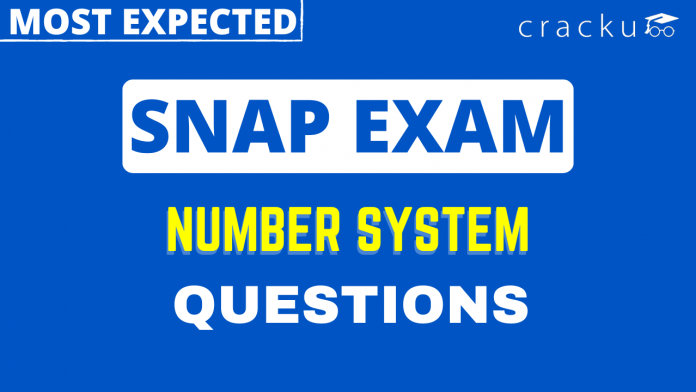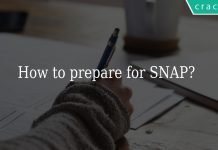SNAP Number System Questions PDF [Important]
The Number System is an important topic in the Number System section of the SNAP Exam. You can also download this free Number System Questions PDF (with answers) for SNAP 2022 by Cracku. These questions will help you to practice and solve the Number System questions in the SNAP exam. Utilize this PDF practice set, which is one of the best sources for practising.
Download Number System Questions for SNAP
Enroll to SNAP 2022 Crash Course
Question 1: If $\frac{1}{x}$ is a positive fraction and $\frac{1}{y}$ is a negative fraction then which of the following statements are true
(A) $\frac{1}{x} + \frac{1}{y}$ is positive
(B) $\frac{1}{x} – \frac{1}{y}$ is positive
(C) $\frac{x – y}{xy}$ is negative
(D) $\frac{1}{xy}$ is positive
(E) $\frac{1}{x^2} – \frac{1}{y^2}$ is positive
Choose the correct answer from the options given below:
a) Only (A) & (B) are true
b) Only (B) & (C) are true
c) Only (D) & (E) are true
d) Only (A) & (E) are true
1) Answer (B)
Solution:
It is given that $\frac{1}{x}$ is positive and $\frac{1}{y}$ is negative, this implies that x is positive and y is negative.
A) $\frac{1}{x}\ +\ \frac{1}{y}$ is positive, we know x is positive, and y is negative, but we cannot conclude which value is greater. Therefore, this may or may not be true.
B)$\frac{1}{x}-\frac{1}{y}$ is positive; we know that x is positive and y is negative. So this statement is definitely true.
C) $\ \frac{\ x-y}{xy}$= -($\frac{1}{x}-\frac{1}{y}$)
As $\frac{1}{x}-\frac{1}{y}$ is positive, $\ \frac{\ x-y}{xy}$ is negative and statement is true.
D) $\frac{1}{xy}$ is negative as x is positive and y is negative. Therefore, the statement is false.
E)$\frac{1}{x^2}-\frac{1}{y^2}$ is positive only when $y^2>x^2$, but we cannot conclude which value is greater. Therefore, this may or may not be true.
Only (B) and (C) are true.
Answer is option B
Question 2: Four different clocks beep after every 25 minutes, 50 minutes, 1 hour 40 minutes and 2 hour 5 minutes. If all clocks beep together at 5 a.m., then when will they next beep together?
a) 12:00 noon
b) 5:00 p.m.
c) 1:20 p.m.
d) 11.20 a.m
2) Answer (C)
Solution:
It is mentioned that four clocks beep for every 25 minutes, 50 minutes, 100 minutes and 125 minutes.
All four clocks beep together for every LCM(25,50,100,125) minutes, i.e. 500 minutes.
500 minutes = 8 hours 20 minutes
All clocks next beep together at 5 am + 8 hours 20 minutes, i.e. 1:20 pm.
Answer is option C.
Question 3: Determine the number of positive integer ‘n’ where 1 $\le\ $ n $\le\ $ 100 and ‘n’ is not divisible by 2, 3 or 5.
a) 23
b) 25
c) 26
d) 29
3) Answer (C)
Solution:
The number of numbers divisible by 2 = 50
The number of numbers divisible by 3 = 33
The number of numbers divisible by 5 = 20
The number of numbers divisible by 2 and 3 = 16
The number of numbers divisible by 2 and 5 = 10
The number of numbers divisible by 3 and 5 = 6
The number of numbers divisible by 2, 3 and 5 = 3
The number of numbers divisible by 2, 3 or 5 = 50 + 33 + 20 – 16 – 10 – 6 + 3 =74
The number of numbers not divisible by 2, 3 or 5 = 100 – 74 = 26
Answer is option C.
Question 4: “xyz” and “zyx” are three digit numbers where x, y, z are distinct digits from 0 to 9. Differenceof xyz and zyx has a factor of 7. What is the maximum possible value of the LCM of x, y and z?
a) 126
b) 72
c) 90
d) 56
4) Answer (A)
Solution:
The difference between the numbers xyz and zyx will be a multiple of 99.
therefore, 99(x-z)= 99*7
x-z =7
No to maximise the LCM of x,y,z we can take x=9, y=7 and z=2
Therefore LCM=126
Question 5: The last two digits of the expression $1(1!)^{1!} + 2(2!)^{2!} + 3(3!)^{3!} + …. + 121(121!)^{121!}$
a) 61
b) 71
c) 81
d) 91
5) Answer (C)
Solution:
From the 5th term onwards the last two of all the terms will 00.
The last two digits of 24 to the power of an even number will be 76 always.
So, last two digits of the above expression will be the last two digits of $1+2\left(2\right)^2+3\left(6\right)^6+4\left(76\right)$
=1+8+139968+304= 140281
So last two digits is 81
Question 6: For a 4-digit number, the sum of its digits in the thousands, hundreds and tens places is 14, the sum of its digits in the hundreds, tens and units places is 15, and the tens place digit is 4 more than the units place digit. Then the highest possible 4-digit number satisfying the above conditions is
6) Answer: 4195
Solution:
Given the 4 digit number :
Considering the number in thousands digit is a number in the hundredth digit is b, number in tens digit is c, number in the units digit is d.
Let the number be abcd.
Given that a+b+c = 14. (1)
b+c+d = 15. (2)
c = d+4. (3).
In order to find the maximum number which satisfies the condition, we need to have abcd such that a is maximum which is the digit in thousands place in order to maximize the value of the number. b, c, and d are less than 9 each as they are single-digit numbers.
Substituting (3) in (2) we have b+d+4+d = 15, b+2*d = 11. (4)
Subtracting (2) and (1) : (2) – (1) = d = a+1. (5)
Since c cannot be greater than 9 considering c to be the maximum value 9 the value of d is 5.
If d = 5, using d = a+1, a = 4.
Hence the maximum value of a = 4 when c = 9, d = 5.
Substituting b+2*d = 11. b = 1.
The highest four-digit number satisfying the condition is 4195
Question 7: For all possible integers n satisfying $2.25\leq2+2^{n+2}\leq202$, then the number of integer values of $3+3^{n+1}$ is:
7) Answer: 7
Solution:
$2.25\leq2+2^{n+2}\leq202$
$2.25-2\le2+2^{n+2}-2\le202-2$
$0.25\le2^{n+2}\le200$
$\log_20.25\le n+2\le\log_2200$
$-2\le n+2\le7.xx$
$-4\le n\le7.xx-2$
$-4\le n\le5.xx$
Possible integers = -4, -3, -2, -1, 0, 1, 2, 3, 4, 5
If we see the second expression that is provided, i.e
$3+3^{n+1}$, it can be implied that n should be at least -1 for this expression to be an integer.
So, n = -1, 0, 1, 2, 3, 4, 5.
Hence, there are a total of 7 values.
Question 8: Which of the given statements is an INCORRECT representation of the expression $1\frac{3}{4} \div \frac{1}{2}$ is ________.
a) Number of halves in $1\frac{3}{4}$
b) $1\frac{3}{4}$ times reciprocal of $\frac{1}{2}$
c) Half of $1\frac{3}{4}$
d) The expression is about finding the number whose half is $1\frac{3}{4}$
8) Answer (C)
Solution:
$1\frac{3}{4} \div \frac{1}{2}$ can be written as $\ \frac{\ 1\frac{3}{4}}{\frac{1}{2}}$
option C – Half of $1\frac{3}{4}$ will be written as $\ \frac{\ 1\frac{3}{4}}{2}$
Therefore, answer is option C.
Question 9: A positive integer when divided by q leaves remainder 21. When double that number isdivided by q, the remainder is 13. Then, q is _________.
a) 21
b) 29
c) 39
d) 37
9) Answer (B)
Solution:
Let the positive no. be N
N = kq + 21
N’ = 2N = 2kq + 42
Now N’ leaves a remainder of 13 when divided by q
So, N’ = pq + 13
Therefore Remainder when 42 is divided by q should be 13 which is only possible when q=29.
Question 10: Arrange the following rational numbers in ascendingorder:
(A) $\frac{-4}{5}$
(B) $\frac{-5}{12}$
(C) $ \frac{-7}{18}$
(D) $\frac{-2}{3}$
a) (A), (B), (D), (C)
b) (C), (D), (B), (A)
c) (A), (D), (B), (C)
d) (D), (C), (B), (A)
10) Answer (C)
Solution:
We have :
$-\frac{4}{5}\ ,\ -\frac{5}{12}\ ,\ -\frac{7}{18}\ ,\ -\frac{2}{3}$
Now LCM is 180
so we get :
$-\frac{144}{180}\ ,\ -\frac{75}{180}\ ,\ -\frac{70}{180}\ ,\ -\frac{120}{180}$
Now arranging in ascending order
we get :
$-\frac{144}{180}\ <\ -\frac{120}{180}<-\frac{75}{180}<-\frac{70}{180}$
so order is A<D<B<C
Take SNAP mock tests here
Enrol to 10 SNAP Latest Mocks For Just Rs. 499
Question 11: The dimensions of a floor are $18\times24$. What is the smallest number of identical square tiles that pave the entire floor without the need to break any tile?
a) 6
b) 24
c) 8
d) 12
11) Answer (D)
Solution:
We have dimensions : (24*18)
LCM (24,18) =72
HCF ( 24, 18) = 6
Now Area of floor: 432
In order to minimise the number of tiles considering a tile with a dimension equivalent to the HCF, we have the dimension of the tile to 6*6 = 36 units.
A total of $\frac{432}{36}$ = 12 tiles are required.
Minimum number of tiles that pave the entire floor :(LCM)^2/Area = 12
Question 12: M is a 4-digit number. If the left most digit is removed, then the resulting three digit number is $\frac{1}{9}^{th}$ of M. How many such M’s are possible?
a) 10
b) 9
c) 8
d) 7
12) Answer (D)
Solution:
According to question,
Number AXYZ/9 = XYZ
It can be written as
A000/9 + XYZ/9 = XYZ
A000/9 + XYZ/9 = 9XYZ/9
A000/9 = 8XYZ/9
A000 = 8XYZ
We have to find the maximum value of A so that when A000 is divided by 8 gives three digit numbers.
7000/8= 875 and 8000/8=1000.
So, answer is 7.
Question 13: Zahir and Raman are at the entrance of a dark cave. To enter this cave, they need to open a number lock. Raman sees a note on a rock: “ … chest of pure diamonds kept for the smart one … number has six digits … second last digit is 2, third last is 4 … divisible by all prime numbers less than 15 …”. Excited, Zahir and Raman seek your help: which of these can be the first digit of the six-digit number that will help them open the lock?
a) 5
b) 3
c) 9
d) 1
e) 4
13) Answer (E)
Solution:
Let the 6 digit number be _ _ _ 42_
It is divisible by 2,3,5,7,11,13
Since the number is divisible by both 2 and 5 the last digit of the number must be 0.
The number is also divisible by 7, 11, and 13.
Hence the number must also be divisible by 7*11*13.
=7*11*13 = 1001.
A number which is a multiple of 1001 is of the form abcabc.
This is because abc*(1001) = abc*(1000+1) = abc000 + abc = abcabc.
Hence the number is 420420.
The first digit is 4.
Question 14: An encryption system operates as follows:
Step 1. Fix a number k $(k \leq 26)$.
Step 2. For each word, swap the first k letters from the front with the last k letters from the end in reverse order. If a word contains less than 2k letters, write the entire word in reverse order.
Step 3. Replace each letter by a letter k spaces ahead in the alphabet. If you cross Z in the process to move k steps ahead, start again from A.
Example: k = 2: zebra –> arbez –> ctdgb.
If the word “flight” becomes “znmorl” after encryption, then the value of k:
a) 5
b) 4
c) 7
d) Cannot be determined uniquely from the given information
e) 6
14) Answer (E)
Solution:
Flight become znmorl
Let’s assume $k>3$
So flight will become thgilf -> znmrol. Hence the value of k will be 6
Question 15: How many 4-digit numbers, each greater than 1000 and each having all four digits distinct, are there with 7 coming before 3?
15) Answer: 315
Solution:
Here there are two cases possible
Case 1: When 7 is at the left extreme
In that case 3 can occupy any of the three remaining places and the remaining two places can be taken by (0,1,2,4,5,6,8,9)
So total ways 3(8)(7)= 168
Case 2: When 7 is not at the extremes
Here there are 3 cases possible. And the remaining two places can be filled in 7(7) ways.(Remember 0 can’t come on the extreme left)
Hence in total 3(7)(7)=147 ways
Total ways 168+147=315 ways
Question 16: How many pairs(a, b) of positive integers are there such that $a\leq b$ and $ab=4^{2017}$ ?
a) 2018
b) 2019
c) 2017
d) 2020
16) Answer (A)
Solution:
$ab\ =\ 4^{2017}=2^{4034}$
The total number of factors = 4035.
out of these 4035 factors, we can choose two numbers a,b such that a<b in [4035/2] = 2017.
And since the given number is a perfect square we have one set of two equal factors.
.’. many pairs(a, b) of positive integers are there such that $a\leq b$ and $ab=4^{2017}$ = 2018.
Question 17: Let m and n be natural numbers such that n is even and $0.2<\frac{m}{20},\frac{n}{m},\frac{n}{11}<0.5$. Then $m-2n$ equals
a) 3
b) 1
c) 2
d) 4
17) Answer (B)
Solution:
$0.2<\frac{n}{11}<0.5$
=> 2.2<n<5.5
Since n is an even natural number, the value of n = 4
$0.2<\frac{m}{20}<0.5$ => 4< m<10. Possible values of m = 5,6,7,8,9
Since $0.2<\frac{n}{m}<0.5$, the only possible value of m is 9
Hence m-2n = 9-8 = 1
Question 18: How many of the integers 1, 2, … , 120, are divisible by none of 2, 5 and 7?
a) 42
b) 41
c) 40
d) 43
18) Answer (B)
Solution:
The number of multiples of 2 between 1 and 120 = 60
The number of multiples of 5 between 1 and 120 which are not multiples of 2 = 12
The number of multiples of 7 between 1 and 120 which are not multiples of 2 and 5 = 7
Hence, number of the integers 1, 2, … , 120, are divisible by none of 2, 5 and 7 = 120 – 60 – 12 – 7 = 41
Question 19: Let N, x and y be positive integers such that $N=x+y,2<x<10$ and $14<y<23$. If $N>25$, then how many distinct values are possible for N?
19) Answer: 6
Solution:
Possible values of x = 3,4,5,6,7,8,9
When x = 3, there is no possible value of y
When x = 4, the possible values of y = 22
When x = 5, the possible values of y=21,22
When x = 6, the possible values of y = 20.21,22
When x = 7, the possible values of y = 19,20,21,22
When x = 8, the possible values of y=18,19,20,21,22
When x = 9, the possible values of y=17,18,19,20,21,22
The unique values of N = 26,27,28,29,30,31
Question 20: How many integers in the set {100, 101, 102, …, 999} have at least one digit repeated?
20) Answer: 252
Solution:
Total number of numbers from 100 to 999 = 900
The number of three digits numbers with unique digits:
_ _ _
The hundredth’s place can be filled in 9 ways ( Number 0 cannot be selected)
Ten’s place can be filled in 9 ways
One’s place can be filled in 8 ways
Total number of numbers = 9*9*8 = 648
Number of integers in the set {100, 101, 102, …, 999} have at least one digit repeated = 900 – 648 = 252





